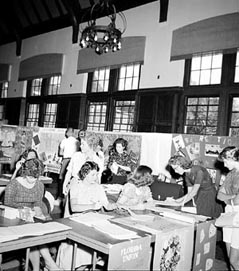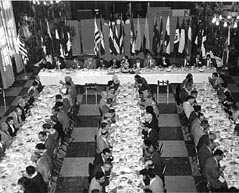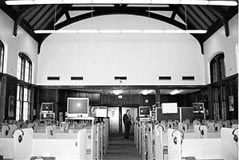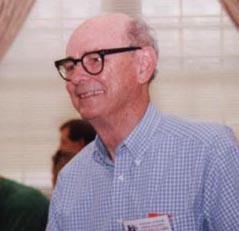Although the Keene Faculty Center opened its doors for the first time just last month, the space it occupies has a long and diverse history. Built in the late 1930s as the University’s Banquet Hall, this elegant room—the upper portion of a two-story Food Services building—was attached to the original Florida Union (Dauer Hall) on the east, and the University Dining Hall (also known as The Commons and later named Johnson Hall) on the west.
As one of the earliest directors of the Florida Union, William E. Rion has seen a lot of activity in the old Banquet Hall. “When the building opened in 1936 or ’37,” says Rion, “the basement portion was used as a short order cafe and bookstore while the upper portion was used for banquets. It was a pretty room,” Rion continues, “and a great multi-purpose facility….It featured chandeliers left over from the construction of University Auditorium.”
During WWII, Army officers-in-training lived in UF dorms and used the room as a mess hall. After the War, the Banquet Hall was officially designated part of the Union and became known as the Florida Union Social Room. Although most large University dinner events shifted to the Hub after its construction in 1950, UF still used the Union Social Room as a banquet hall on occasion, most notably for the annual Caribbean Conference. In the 50s and 60s the Social Room was used for a variety of student activities like information fairs, student elections and pep rallies. “We held smaller campus dances there almost every Friday night,” explains Rion, “and street dances right outside for the larger crowds.” Social Room parties often featured a three-piece band that played from the balcony down to guests and dancers below.
One of the more interesting and regular activities held in the Social Room, according to Rion, was the annual series of international dinners. “These student-planned dinners were held once a month or so,” he recalls, “and featured food, artifacts, music and speakers from a certain country. Students wore traditional dress and exhibited great pride in sharing the culture of their homelands. For more than a decade, these high-profile events provided significant student/faculty involvement.”
After the Florida Union (now the J. Wayne Reitz Union) moved to its current location on Museum Road in 1967, Dauer Hall was turned over to the College of Liberal Arts and Sciences to help provide badly needed space for faculty offices, classrooms and departments. From 1970 until 1997, the Social Room served as a language laboratory, complete with nearly 50 listening stations.
When the preservation-minded Keenes stepped forward to help renovate the structure last year, their interests fit perfectly with the broad historic renovation plans of CLAS. This project both restores a beautiful room to its original dignity and re-inserts it squarely back into the center of campus life. “Since for many decades it was a significant nonacademic gathering space for students,” says Rion, “it’s nice to see this room once again used to enhance out-of-the classroom collegiality—and this time for faculty, who really need such a space.”




